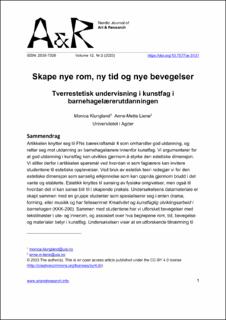Skape nye rom, ny tid og nye bevegelser - Tverrestetisk undervisning i kunstfag i barnehagelærerutdanningen
Peer reviewed, Journal article
Published version

View/
Date
2023Metadata
Show full item recordCollections
Original version
Klungland, M. & Liene, A.- M. (2023). Skape nye rom, ny tid og nye bevegelser - Tverrestetisk undervisning i kunstfag i barnehagelærerutdanningen. Nordic Journal of Art and Research (A & R), 12 (2). https://doi.org/10.7577/ar.5131Abstract
This article is linked to the UN sustainability goal 4, which deals with good education, and is aimed at early childhood teacher education in art subjects. We argue that good education in art can be developed by strengthening the aesthetic dimension. We therefore question how we, as art education teachers, can invite students to aesthetic experiences. By using aesthetic theory, we explain the aesthetic dimension as a form of sensory recognition that is acquired through breaking with the familiar and established forms. Aesthetics is linked to sensing physical surroundings, but also to how what we can sense comes into being in creative practice. The data material has been created together with a group of students who specialize in either drama, visual art, or music and attend the course Creativity and arts-based experimental development in kindergarten (KKK-200). Together with the students, we have explored movements with balls of textile yarn in outdoor and indoor spaces, and reflected over what the terms space, time, movement, and materials mean in art subjects. Our findings show that an exploratory approach to these concepts can provide a new understanding of how space and time are created in the educational situation. In this space-time creation, it is possible to disrupt habitual thinking and turn around habitual teaching methods, which can lead to perceiving the world in new ways. To break with the usual and keep the education open and unpredictable can be experienced as risky for both teachers and students. This risk provides the opportunity for students´ aesthetic experiences and can help them to understand the importance of the aesthetic dimension.
